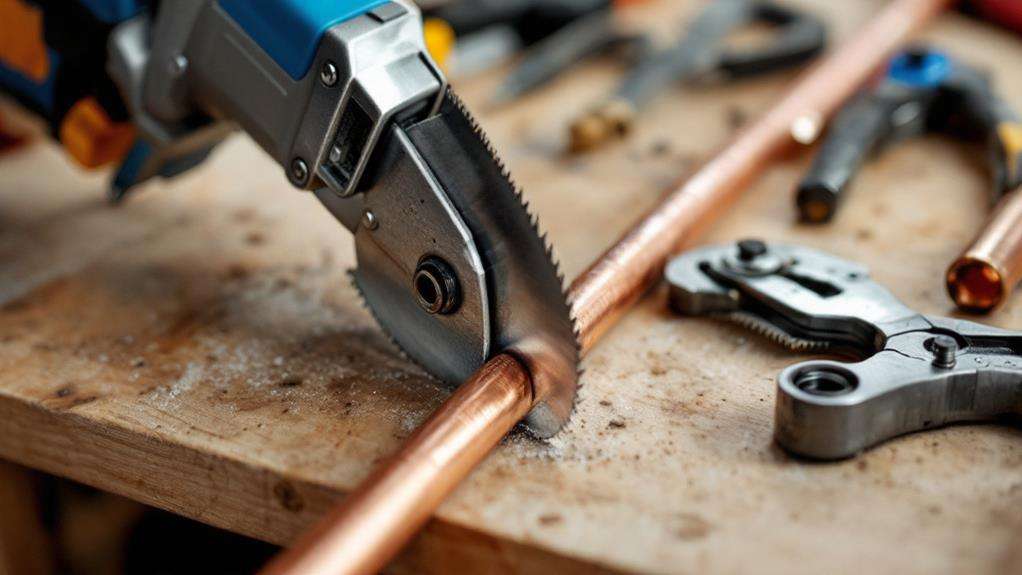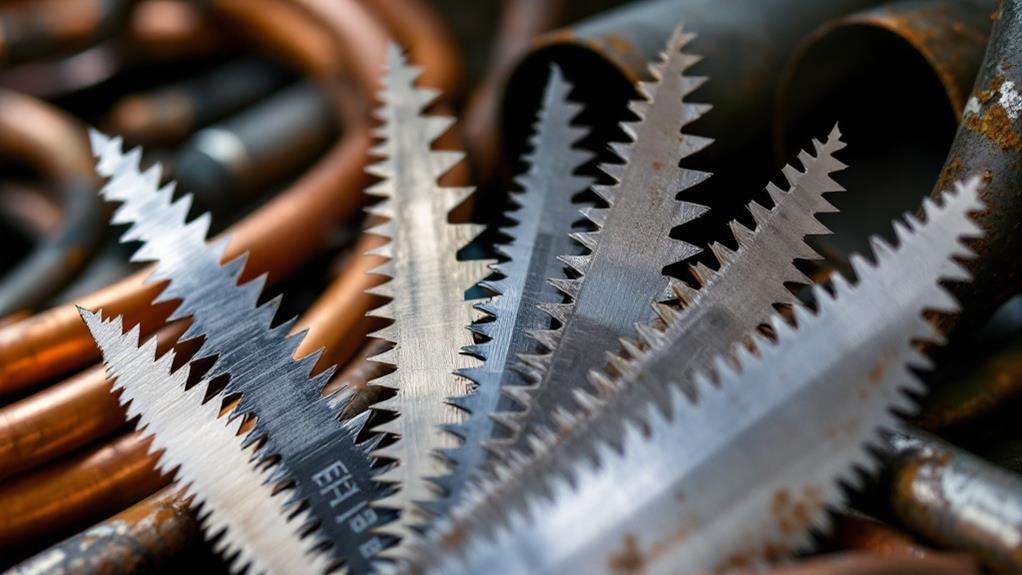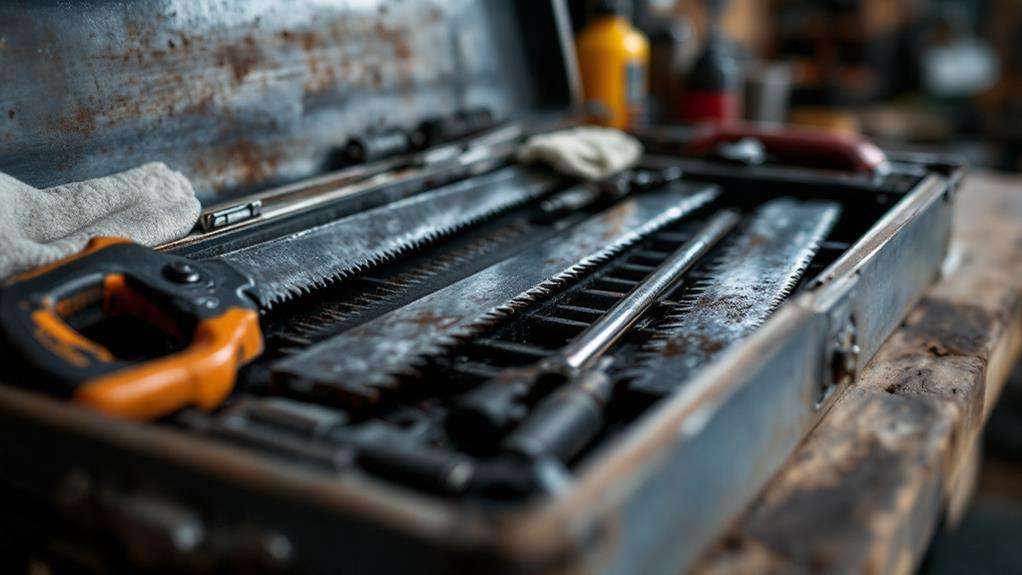Best Hacksaws and Cutting Tools for Plumbing Projects
For your plumbing projects, you'll need a variety of cutting tools. A versatile hacksaw with 18-24 TPI is essential for general cuts. Invest in a pipe cutter for clean, straight cuts on metal pipes and a tubing cutter for plastic ones. Power tools like reciprocating saws and angle grinders can handle tougher materials quickly. Don't forget specialty tools like PVC cutters and copper pipe cutters for precise work. Choose blades made of high-speed steel or bi-metal for durability. Remember to prioritize safety and maintain your tools properly. By selecting the right cutting tools, you'll be well-equipped to tackle any plumbing challenge that comes your way.
Types of Plumbing Cutting Tools
While many plumbing tools are designed for tightening and loosening, cutting tools play an essential role in pipe installation and repair. When working on plumbing projects, you'll need a variety of cutting tools to handle different materials and situations.
The hacksaw is a versatile cutting tool that you'll use frequently. It's perfect for cutting through pipes, nuts, bolts, and screws. Remember to keep spare blades in your truck for efficiency. For precise cuts on metal pipes, a pipe cutter is your go-to tool. It provides clean, straight cuts without the need for excessive force.
When dealing with plastic pipes, a tubing cutter is ideal. It's designed to make quick, clean cuts without damaging the pipe. For larger cutting jobs or working in tight spaces, a reciprocating saw can be crucial. It's powerful enough to cut through most plumbing materials quickly.
Don't forget about hole saws for creating openings in walls or cabinets for pipe installation. After cutting, use a deburring tool to smooth out rough edges. While not cutting tools, a pipe wrench, adjustable wrench, and plumber's tape are essential for completing your plumbing tasks effectively.
Choosing the Right Hacksaw
Selecting the right hacksaw is essential for efficient and precise cutting in plumbing projects. When choosing a hacksaw for your plumbing toolkit, consider the blade's teeth per inch (TPI) and material. For cutting thicker pipes or softer metals, opt for a course-grade hacksaw with 14-18 TPI. If you're working with thin or fragile materials, a fine-grade hacksaw with 24-30 TPI will provide smoother cuts.
Carbon steel blades are versatile and affordable for general plumbing tasks, while high-speed steel and bi-metal blades offer increased durability for more demanding projects. Look for hacksaws with useful features that enhance functionality, such as:
- On-board blade storage for quick replacements
- Pivoting blade positions for improved accessibility in tight spaces
- Jab saw options for added versatility
The DEWALT 5-in-1 Hacksaw is a great all-around choice, offering multiple saw configurations and a high-tension blade for precise cuts. At $31, it's a worthwhile investment for serious DIYers. For smaller plumbing projects or extra-smooth cuts on thin materials, the Project Source 6-in Extra Fine Cut Hacksaw is an affordable option at $8. However, it's not suitable for heavy-duty applications, so consider your project needs when making your selection.
Power Tools for Pipe Cutting

Power tools have revolutionized pipe cutting in plumbing, making the job faster and more efficient. When you're tackling heavy-duty materials like carbon steel pipes, an angle grinder is your best bet. This powerful tool provides aggressive cutting performance, slicing through tough metals with ease.
For versatility, you can't go wrong with a reciprocating saw, also known as a Sawzall. It's the go-to tool for plumbers working with various metals, including copper and stainless steel. If you're dealing with large-diameter pipes, this saw will be your trusted companion.
When it comes to softer materials like PVC, you've got options. A hand saw offers precise control, especially in tight spaces. For smaller diameters, a tubing cutter is ideal, providing clean, burr-free cuts on PVC and multilayer tubing.
Don't forget about pipe reamers – they're vital for smoothing out the inner diameter of a pipe after cutting. This step guarantees there are no rough edges that could cause leaks or blockages.
Specialty Cutting Tools
Choosing the right specialty cutting tool can make all the difference in your plumbing projects. When it comes to cutting pipes, you'll want to opt for the material and size you're working with. For PVC pipes up to 1.5 inches in diameter, a ratcheting PVC pipe cutter is your best bet. Its sturdy construction and sharp stainless steel blades deliver precise cuts, while the ratcheting mechanism makes it easy to use.
If you're working with copper pipes, select a specialized copper pipe cutter. These compact and lightweight tools feature precision-ground hardened steel cutting wheels for smooth cuts on pipes from 1/4 inch to 1 inch in diameter. For various tubing materials, tubing cutters with adjustable jaws and integrated deburring blades are ideal.
When tackling larger projects, consider these heavy-duty options:
- Guillotine-Style Pipe Cutters: Fast and efficient for pipes up to 2 inches
- Chainsaw Pipe Cutters: Perfect for large-diameter pipes up to 12 inches
- Ratcheting PVC Pipe Cutters: Handles pipes up to 1.5 inches with ease
Each of these pipe-cutting tools offers unique features to deliver precise and smooth cuts, making your plumbing projects more manageable and efficient.
Blade Materials and Properties

Understanding blade materials and properties is indispensable for selecting the right cutting tool for your plumbing projects. When choosing blades for your hacksaw or other cutting tools, you'll encounter several options, each with its own strengths and weaknesses.
Carbon steel blades are a popular choice for general DIY plumbing tasks. They're versatile and affordable, but they'll wear down faster than other materials. If you're cutting metal frequently, consider high-speed steel blades. These can withstand higher temperatures and offer better durability, making them ideal for tougher plumbing jobs.
For a balance of durability and performance, bi-metal blades are an excellent choice. While they're more expensive, they'll last longer and provide consistent cutting quality. When precision is pivotal, look for superfine-grade blades with 30-32 TPI (teeth per inch). These produce cuts with minimal burrs and smooth edges, perfect for delicate plumbing work.
Fine-grade blades with 24-30 TPI are best for thin or fragile materials, furnishing very smooth cuts. They're ideal for working with smaller pipes or fittings where a clean finish is indispensable. By understanding these blade properties, you'll be better equipped to choose the right tool for your specific plumbing needs.
Safety Considerations
While selecting the right blade is key for effective plumbing work, prioritizing safety is equally important. When using cutting tools for plumbing projects, you'll need to take several precautions to protect yourself and guarantee a safe working environment. Always wear safety glasses to shield your eyes from debris that may fly during cutting operations. Secure your workpiece firmly to prevent unexpected movements that could lead to accidents or injuries.
When using power tools, remember to:
- Unplug them when not in use to avoid accidental activation
- Ascertain adequate ventilation, especially when cutting metal, to minimize exposure to harmful fumes
- Keep your cutting tools sharp and well-maintained for safer and more efficient operation
Maintenance and Care

Proper maintenance and care of your plumbing tools are essential for their longevity and ideal performance. Regular maintenance guarantees your tools are pivotal for tackling any job efficiently. For hacksaws, clean and lubricate the steel blades regularly to maintain aggressive cutting performance and extend their life. Store spare blades in a dry environment to prevent rust and damage. Don't forget to inspect your hacksaw frames for cracks or damage, replacing them if necessary for safe operation.
When it comes to pipe cutters and reaming tools, keep them sharp or replace them when dull to ensure smooth, accurate cuts. This is especially important when you're cutting pipe in place. For power tools like reciprocating saws and angle grinders, proper maintenance and calibration are indispensable for optimizing cutting efficiency. Don't neglect your drain snake, as it's a critical tool every plumber needs.
Advanced Cutting Techniques
Over time, plumbers develop advanced cutting techniques that enhance efficiency and precision in their work. When dealing with tough materials like stainless steel or copper pipes, you'll need to ponder various cutting methods and tools. Angle grinders offer quick results but can produce metal shards that might damage nearby fixtures. For a more controlled approach, you might opt for a "cheese cutter" Lenox saw, which can handle many pipe cutting tasks without complex techniques.
When working on water heaters or toilet tanks, remember these tips:
- Use a plunger to remove water before cutting, reducing splashing.
- Keep a bucket handy when removing plastic caps from tank bolts.
- Contemplate using pipe clamps to stabilize pipes made of various materials during cutting.
Your plumbing tools list should include options for different cutting capacities and saw features. Look for tools with compact designs that can handle PVC pipes as well as metal ones. When dealing with stripped tank-to-bowl bolts, weigh the time-saving benefits of using a grinder against potential higher charges for customers. Always prioritize safety and efficiency in your cutting techniques.
